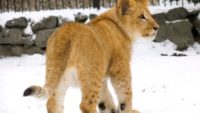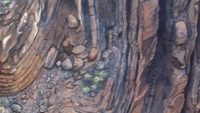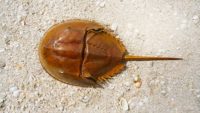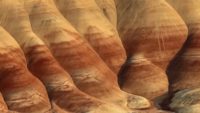By Ken Ham During research expeditions in 2017 and 2018, a “perfectly preserved” cave lion cub was found in the Siberian permafrost by scientific researchers working alongside mammoth tusk hunters. The cub was “less than two months old when she died, [and] was found covered in golden fur and even had teeth, skin, soft tissue and whiskers still intact.” Researchers believe she must have been rapidly buried in a mudslide to preserve her with such detail. That flood triggered the ice age—when this cave lion, a member of the cat kind, would have lived—and she was probably buried by a [More]
By Dr. Andrew A. Snelling Carbon-14 (or radiocarbon) is a radioactive form of carbon that scientists use to date fossils. But it decays quickly. …read more Source: AIG Daily
‘Fossil fuel’ takes a lot less time to form than commonly believed …read more Source: creation.com
By Dr. Jerry Bergman An example of how members of the scientific establishment quashed dissent with authoritarian tactics because it does not align with Darwinian orthodoxy …read more Source: AIG Daily
About 1,600 years ago, salt miners in Iran apparently left their lamb lunch down the shaft. Their loss became scientists’ gain. The now-mummified sheep carcass suggests that salt helps preserve sheepskin DNA. The research results, published in Biology Letters, showed probably the best-preserved DNA from any skin from that time.1 The Iranian and European team used radiocarbon dating to help establish an age e… More… …read more Source: icr.org
Sneak peek of a insightful article from the latest Creation magazine. Soft flexible nerves have been found in a Triceratops fossil …read more Source: creation.com
Not only can species change over time, but they can merge and split as well. This can be described with the ‘braided baramin’ concept. …read more Source: creation.com
By Ken Ham The Bible gives us a framework for explaining dinosaurs in terms of thousands of years of history, including the mystery of when they lived and what happened to them. …read more Source: AIG Daily
Eight species of dinosaurs were recently unearthed in the Prince Creek Formation of northern Alaska.1 The latest discovery, published in Current Biology, claims the bones were near the North Pole at the time of their burial in Cretaceous System rocks (about 80-85 degrees north latitude).1 This would give the region about 120 days of total darkness each year, making it difficult for dinosaurs to survive in such an ex… More… …read more Source: icr.org
By Dr. Andrew A. Snelling Helium diffuses so rapidly that all the helium should have leaked out of rocks in less than 100,000 years. …read more Source: AIG Daily
By Troy Lacey Evolutionists suggest Chinese “Dragon Man” is a 100,000-year-old hominid while biblical creationists understand the discovery in light of post-Babel dispersion. …read more Source: AIG Daily
By Dr. Andrew A. Snelling The petrology of the Tapeats Sandstone is consistent with the global Genesis flood. …read more Source: AIG Daily
By Troy Lacey The Creator’s provision for the horseshoe crab is provision for us. …read more Source: AIG Daily
By Troy Lacey Answers to common objections to the existence of real dinosaurs: supposedly fabricated bones, scientific concerns, and theological issues. …read more Source: AIG Daily
For years, scientists kept ignoring the evidence of their own eyes because of the pressure to ‘conform’. …read more Source: creation.com
Does a good society have evolutionary origins? …read more Source: creation.com
A call for a radical reappraisal of all previous interpretations of mudstone deposits …read more Source: creation.com
By Dr. Andrew A. Snelling The earth is surrounded by a magnetic field that protects living things from solar radiation. Without it, life could not exist. …read more Source: AIG Daily
Did T. rex relatives live and die together, or are the scientists right that these Teratophoneus fossils were buried together in a flood? …read more Source: creation.com
When fire ants threaten lizard populations, it really is ‘survival of the fittest’. But ‘evolution’? No! …read more Source: creation.com
By Dr. Danny R. Faulkner The star Betelgeuse drastically faded in 2019, but now it’s back to its normal, bright self—what does that mean for stellar evolution or creation? …read more Source: AIG Daily
By Dr. Andrew A. Snelling If sediments have been accumulating on the seafloor for three billion years, the seafloor should be choked with sediments many miles deep. …read more Source: AIG Daily
No other book before or since has so effectively substantiated Christians’ belief in the historicity of the Genesis Flood. Read More
By Ken Ham Elephants use their incredibly dexterous trunks almost like a hand with fingers. This trunk boasts around 40,000 individual muscles and can be used to suck up food and water. But the elephant’s trunk isn’t just a “simple straw”—and new research shows it’s more complicated than was initially thought. A recent study detailed measurements during one zoo elephant’s feeding time. They discovered the elephant can “dilate its nostrils to boost its trunk’s carrying capacity.” Each of an elephant’s two nostrils can increase in volume by a stunning 64%! The “flow rate of water through the trunk averaged about [More]
By Dr. Monty White Creationists are often asked, “How is it possible for the earth’s population to reach billions of people if the world is only about 6,000 years old and if there were just two humans in the beginning?” …read more Source: AIG Daily
Daniel Stern-Cardinale and Joshua Swamidass have made many false claims about creationism and creationists. DSC and Erika “Gutsick Gibbon” were at it again recently, but once again refused to listen to our answers. Read More
Scientists recently discovered a diverse assemblage of fossils in South Africa claimed to be some of the earliest land plants.1 Known as seedless vascular plants, the fossils were determined to be from early Devonian system strata. Most shockingly, secular paleogeography models indicate these plants grew at about 75 degrees South Latitude, very close to the South Pole! Discovered in 2015 during the expansion of the Mpofu… More… …read more Source: icr.org













































